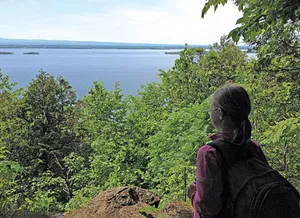
We hear all the time about wildfires raging out west, but it’s rare to find evidence of forest fires on random woodland walks in Vermont. Ecologists sometimes refer to eastern deciduous forests as “asbestos forests” because, like the heat-resistant, toxic fibers, they are generally so damp it’s hard to get them to burn. Still, sometimes it happens. I know of two kid-friendly hikes in the Burlington area where you can see signs of fire: Eagle Mountain and Sunny Hollow Natural Area. These two burned forests look very different, because they have very different soils. Eagle Mountain is a great short hike. Alltrails.com says it’s 1.5 miles to the top and back, with an elevation gain of 252 feet. If you’re trying to sell it to your kids, tell them it’s much shorter than Mount Philo! A few weeks ago, I hiked the trail with my friend Alicia on a rainy day. The thing that initially jumped out to us was all the different textures we saw. There are many ledgy areas with bedrock sticking out of the soil. The rock was the same orangey dolostone you find at Rock Point in Burlington; it kind of has a crosshatched texture, and it’s also covered with fuzzy, fluorescent-green moss. In May, Eagle Mountain hosts a riot of ephemeral spring wildflowers, such as trillium and blue cohosh, that go all out on the forest floor in the brief window of time when the ground has thawed but the trees haven’t leafed out yet. The presence of some of these species tells us that the soil here is calcium-rich. The ledges also offer fun, kid-size nooks and crannies to explore. Trees with different types of shaggy bark line the trails, including shagbark hickory (large shags), hop hornbeam (delicate shags) and northern white cedar (“cat scratch” shags). The first hint that there had been a fire here came as we started walking on the mowed path heading to the summit and noticed some dramatic black stumps. We went off-trail to investigate a few of the more striking specimens, which definitely looked charred. We decided to test them to see if the blackened part was charcoal. Pro tip: Rub the black part on paper. If it makes black marks, it’s charcoal. If it doesn’t, it’s a fungus that looks a lot like charcoal. What we were seeing was definitely charcoal. As we walked farther,…
Good Nature: Eagle Mountain and Sunny Hollow — A Tale of Two Fires

